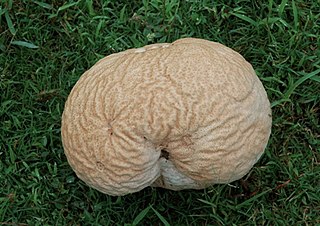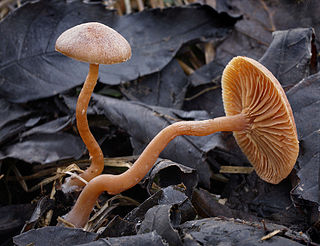
Calvatia is a genus of puffball mushrooms that includes the spectacular giant puffball C. gigantea. It was formerly classified within the now-obsolete order Lycoperdales, which, following a restructuring of fungal taxonomy brought about by molecular phylogeny, has been split; the puffballs, Calvatia spp. are now placed in the family Agaricaceae of the order Agaricales.

Hypholoma is a genus of fungi which are quite well known due to the commonness of sulphur tuft on stumps in temperate woodlands. Species in this genus are easily recognizable because the dark spores create a distinctive greenish effect on the yellow cap underside. Hypholoma means "mushrooms with threads" because of the thread-like veil that connects the cap to the stem when young and for the bundles of rhizomorphs which radiate outwards from the stem base. Other well-known species are H. capnoides and H. lateritium.

Chlorophyllum is a genus of large agarics similar in appearance to the true parasol mushroom. Chlorophyllum was originally coined in 1898, a time when spore color was the deciding factor for differentiating genera. It was termed in order to describe the poisonous green-spored C. molybdites which shared many characteristics of the mushrooms within the genus Lepiota but lacked the all important white spores. The name derives from Greek Chloro meaning green and phyllo meaning leaf. It remained as a monotypic genus until recently when modern DNA analyses concluded that many of the mushrooms contained in the genus Macrolepiota actually had more in common genetically with the Chlorophyllum molybdites than with the other members of the Macrolepiota. The genus has a widespread distribution, with many species found in tropical regions. The best known members are the edible shaggy parasol, a name applied to three very similar species Chlorophyllum rhacodes, C. olivieri and C. brunneum, and the poisonous C. molybdites, which is widespread in subtropical regions around the world.

Gymnopilus purpuratus is a species of agaric fungus in the family Hymenogastraceae. It grows in clusters on dead wood, tree stumps and wood chip mulch. It is widely distributed and has been recorded in Argentina, Australia, Chile, New Zealand, the UK and Germany. It has a broadly convex cap covered in small dry reddish-brown scales, a stout yellow stem beneath reddish brown, wine-red to purple vertical fibres, and a thick rusty orange spore print.

Metarhizium is a genus of entomopathogenic fungi in the Clavicipitaceae family. With the advent of genetic profiling, placing these fungi in proper taxa has now become possible. Most turn out to be the asexual forms (anamorphs) of fungi in the phylum Ascomycota, including Metacordyceps spp.

The Meruliaceae are a family of fungi in the order Polyporales. According to a 2008 estimate, the family contains 47 genera and 420 species. As of April 2018, Index Fungorum accepts 645 species in the family.
Phomatospora is a genus of fungi within the class Sordariomycetes, and since 2016, in the family Phomatosporaceae and order Phomatosporales. They are found in terrestrial, freshwater and marine habitats, across the world except Russia and Canada.

Cymatoderma is a widely distributed genus of poroid fungi in the family Meruliaceae.

Disciseda is a genus of gasteroid fungi in the family Agaricaceae. It is a widely distributed genus that is prevalent in arid zones. Disciseda was circumscribed by mycologist Vassiliĭ Matveievitch Czernajew in 1845.

Dichomitus is a genus of poroid crust fungi in the family Polyporaceae. It was circumscribed by English mycologist Derek Reid in 1965.
Podonectria is a genus in the monotypic Podonectriaceae family of fungi. They are parasitic fungus on scale insects, other fungi, or on substrates that had previously colonized by other fungi.

George Edward Massee was an English mycologist, plant pathologist, and botanist.

Tubaria is a genus of fungi in the family Tubariaceae. The genus is widely distributed, especially in temperate regions. Tubaria was originally named as a subgenus of Agaricus by Worthington George Smith in 1870. Claude Casimir Gillet promoted it to generic status in 1876. The mushrooms produced by species in this genus are small- to medium-sized with caps ranging in color from pale pinkish-brown to reddish-brown, and often with remnants of the partial veil adhering to the margin. Mushrooms fruit on rotting wood, or, less frequently, in the soil. There are no species in the genus that are recommended for consumption.

Podoserpula is a genus of fungi in the family Amylocorticiaceae. The genus contains six species including the type species, P. pusio, commonly known as the pagoda fungus. Species of the genus Podoserpula produce fruit bodies consisting of up to a dozen caps arranged in overlapping shelves, attached to a central axis. Its unique shape is not known to exist in any other fungi. The genus is known to occur in Australia and New Zealand, Venezuela, Madagascar, and New Caledonia.

Tremellodendropsis is a genus of clavarioid fungi in the family Tremellodendropsidaceae. Species are distinguished microscopically by having partly septate basidia, a feature that led to their former placement within the Auriculariales or Tremellales. Molecular research, based on cladistic analysis of DNA sequences, has, however, shown that they form a distinct group within the Agaricomycetes.

Cymatoderma caperatum is a fungus species in the family Meruliaceae. It was originally described in 1849 as a species of Thelephora by Miles Joseph Berkeley and Camille Montagne. Derek Reid transferred it to Cymatoderma in 1956.

Termitomyces umkowaan is a species of agaric fungus in the family Lyophyllaceae. Found in South Africa, it was described as new to science in 1889 by Mordecai Cubitt Cooke and George Edward Massee from collections made in Durban. Cooke noted that was "called Umkowaan by the natives, and is delicious when cooked, much superior to the common mushroom." Derek Reid transferred the fungus to the genus Termitomyces in 1975.

Pholiota glutinosa is a species of poisonous fungi in the genus Pholiota, endemic to New Zealand.















